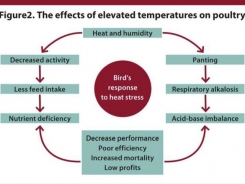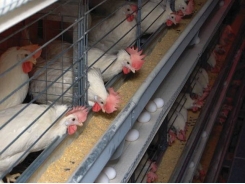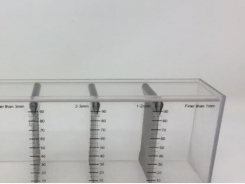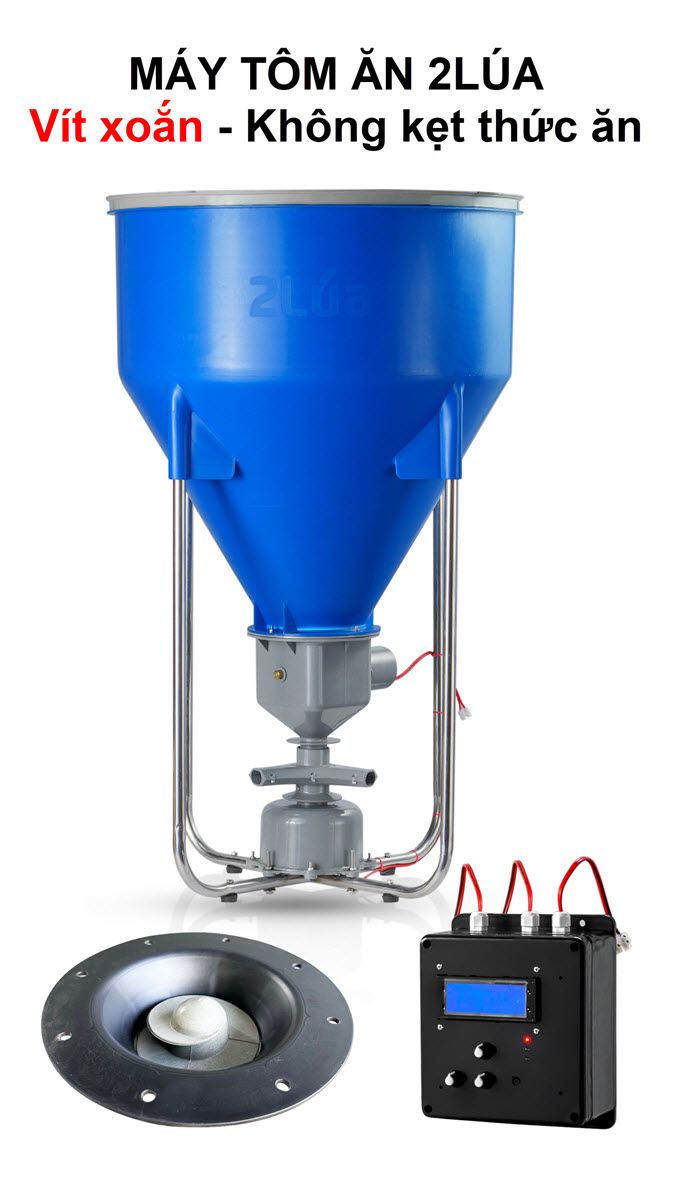Selecting dietary energy levels for layers

Even when the same energy and protein intake is maintained for all three energy levels, egg size will be larger in hens fed the high energy diets.
Increased levels lead to improved feed efficiency
A wide range in dietary energy levels is applied in the U.S. egg industry. Many producers believe moderate dietary energy levels are required for optimal profit while other subscribe to either low or high specifications. Dietary energy levels can be divided into three ranges:
- High dietary energy levels (1365-1275 ME kcal/lb) - Producers believe that higher feed cost is offset by improved feed conversion efficiency.
- Moderate dietary energy levels (1305-1270 Me kcal/lb with added fat) - Producers accept that the cost of extra energy is offset by beneficial effects on egg size and mass. After egg size reaches large grade they accept that the cost of extra energy is not justified. Generally producers maintain a minimum of 0.5% added fat in diets to improve palatability and to reduce dust.
- Low dietary energy levels (1215-1280 ME kcal/lb without added fat) - Producers using these levels believe that the increased cost of energy outweighs the financial benefits from increased revenue.
The major reason for feeding increased dietary energy levels is to improve feed efficiency. As dietary energy increases, feed intake is lowered with a consequential improvement in feed conversion.
In a given simulation hens were fed high, moderate and low energy diets consuming 19.1, 20.1 and 20.7 lbs/100 hens/day. When production attained 88%, feed efficiency corresponded to 2.63, 2.77 and 2.86 lbs/dozen for the high, moderate and low energy diets respectively. Reducing average production by 5% from 87% to 82% reduced feed efficiency by 0.17 lbs/dozen eggs and increased feed cost 1.7¢/dozen eggs. If feed costs were $200/ton a 5% reduction in production would increase feed cost by 1.7¢ per dozen.
1/ Calculating the value of added energy
Using a $200 per ton feed cost for a medium energy diet, it is possible to calculate that feed cost per dozen will be 27.7¢. To calculate how much one can afford to pay for the high energy diet and still have the same or a lower feed cost per dozen, the value of 27.7¢ per dozen is divided by 2.63 lbs per dozen and then multiplied by 20. It is calculated that the producer can pay up to $210.65 or $10.65 more per ton for the 67 additional calories and still have the same or a lower feed cost per dozen. It is calculated that as long as the savings in feed cost obtained by reducing energy by 38 calories in the low energy diet is $6.29/ton or more, feed cost per dozen will be equal or less than that of hens feed moderate energy diets.
2/ Effect of dietary energy level
Even when the same energy and protein intake is maintained for all three energy levels, egg size will be larger in hens fed the high energy diets. In some cases depending on egg prices and environmental temperature the value of high energy on egg size could be much greater than the improvement in feed efficiency. Hens fed a corn-soy diet with a minimum of 0.5% added fat or vegetable oil, in the case of organic diets, will produce on average 0.5% more eggs than hens fed the same diet with no added fat or oil.
In some cases, older hens held at low temperature will not completely adjust energy intake as dietary energy is changed. Because of variation in egg and feed prices it is difficult for producers to select the dietary energy level which contributes to optimal return. Of all the nutrients, energy is the most difficult to determine in order to obtain maximum contribution. Hens will consume more or less feed as the dietary energy level changes to satisfy their energy needs which are influenced by body weight, egg mass, activity, production, ambient temperature and genetic factors.
Low dietary energy levels are more appropriate when low egg prices are obtained or when high cost of fat, low cost of grain, high flock age prevail and low house temperatures occur during winter.
Higher dietary energy levels are more beneficial to optimal egg size. Wide variation in egg price occurs due to grade or with low fat cost, high grain cost, in young flocks or at high temperature.
Precise environmental control is a requirement for producers electing to use high energy diets to maximize feed efficiency. If hens are too cold when fed high energy diets they will over consume calories and feed compared to hens fed diets with lower energy.
Selecting incorrect energy levels can adversely affect cost by up to 0.5¢ per dozen. Increasing feed cost by only 1¢ per dozen represents $250,000 annually for a complex of 1 million hens. This loss is small compared to the cost of either over- or under-consumption of energy. If house temperature increases below accepted levels (75F to 80F) feed intake will increase and egg size and body weight will be above target.
If hens are exposed to high ambient temperature, energy intake will decrease below that needed to optimize performance and production and body weight and egg grade will drop below standard. Over- or under-consumption of energy can increase feed cost by up to 4¢ per dozen or more.
3/ The bottom line
Feeding diets containing an optimal energy level to allow hens to consume feed to attain their requirements for energy and amino acids is difficult and complex but applying the following guidelines return should be optimized:
- Determine the optimal dietary energy level under current condition for each production unit.
- Achieve the correct intake of energy per hen by maintaining an ideal temperature in the house and tailor a feed allocation program to optimize performance.
- Evaluate feeding programs to provide a positive return expressed in cents per dozen. It is necessary to feed each flock as close to optimal energy and amino acid intake as possible. This presumes an accurate record keeping system to allow correlation between performance and critical nutrient intake.
- Recognize when energy and amino acid requirements for optimal performance deviate from optimal return. Under conditions of low egg price it may be possible to reduce losses by feeding graded amino acid levels lower than those required for optimal performance. Although production is reduced from 1% to 3% depending on the level of reduction in critical amino acid specifications, the loss in value of eggs is less than the potential or actual saving in feed cost.
- Econometric feeding increases return regardless of the strategies of competitors.
The more information the producer has available when selecting dietary specifications, the more efficient the feeding program becomes. Small improvements can result in significant benefits especially with large flocks.
Related news
Tools

Phối trộn thức ăn chăn nuôi

Pha dung dịch thủy canh

Định mức cho tôm ăn

Phối trộn phân bón NPK

Xác định tỷ lệ tôm sống

Chuyển đổi đơn vị phân bón

Xác định công suất sục khí

Chuyển đổi đơn vị tôm

Tính diện tích nhà kính

Tính thể tích ao




 How much DDGS will benefit layers?
How much DDGS will benefit layers?  Crumbler, crumble quality influence broiler growth
Crumbler, crumble quality influence broiler growth